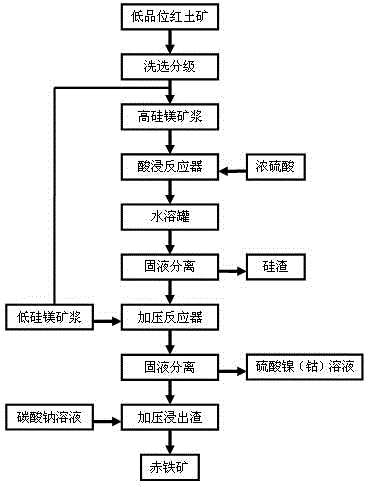Method of recycling nickel, cobalt and iron from low-grade laterite-nickel ore
A laterite nickel ore, low-grade technology, applied in the field of metallurgy, can solve the problems of long process cycle, long leaching time, environmental pollution, etc., and achieve the effect of simple operation and maintenance, low investment cost and operating cost
- Summary
- Abstract
- Description
- Claims
- Application Information
AI Technical Summary
Problems solved by technology
Method used
Image
Examples
Embodiment 1
[0043] Take 500Kg (dry basis) and grind to 80 mesh 2 # Add 500Kg water to the high-silicon magnesium ore to make high-silicon magnesium slurry, and prepare 500Kg of concentrated sulfuric acid (98%). Strictly control the flow rate with the mortar pump and the concentrated sulfuric acid pump to synchronously feed the high-silicon magnesium pulp and concentrated sulfuric acid into the feed port of the twin-screw pusher reactor. Afterwards, it is pushed out of the twin-screw pusher reactor. The total reaction time is 10 minutes.
[0044] After cooling down, the reaction material containing the crisp honeycomb solid paste is simply crushed and then poured into a water immersion tank, 1500Kg of water is added, and stirred for about 30 minutes. Pump the water-soluble slurry into a plate and frame filter press for solid-liquid separation and filter residue washing to obtain 205Kg (dry) atmospheric acid leaching filter residue (A1), 1450L atmospheric pressure acid leaching filtrate (...
Embodiment 2
[0056] Take 500Kg (dry basis) and grind to 80 mesh 5 # Add 500Kg water to the high-silicon magnesium ore to make high-silicon magnesium slurry, and prepare 500Kg of concentrated sulfuric acid (98%). Strictly control the flow rate with the mortar pump and the concentrated sulfuric acid pump to synchronously feed the high-silicon magnesium pulp and concentrated sulfuric acid into the feed port of the twin-screw pusher reactor. Afterwards, it is pushed out of the twin-screw pusher reactor. The total reaction time is 10 minutes.
[0057]After cooling down, the reaction material of the crisp and loose honeycomb solid paste is simply broken and poured into a water immersion tank, and 1500Kg of water is added, and stirred for about 30 minutes. Pump the water-soluble slurry into a plate and frame filter press for solid-liquid separation and filter residue washing to obtain 230Kg (dry) atmospheric acid leaching filter residue (A2), 1400L atmospheric pressure acid leaching filtrate (B...
Embodiment 3
[0070] The normal-pressure acid leaching stage of the present embodiment is the same as that of Example 1, and 3 Xinka low-silicon magnesium ore was replaced by 6 # Indonesian low silicon magnesium ore.
[0071] Take 4000g (dry) 6 # For low-silicon magnesium ore, add 8000ml of washing solution (E1) to make limonite slurry, then transfer it to PARR4557 autoclave (17L), and then add 3000ml of normal pressure acid leaching filtrate (B1) into the autoclave. After sealing the autoclave, control the temperature and heat. The pressure is not higher than 3.0Mpa. When the temperature rises to 220°C, continue to heat at a constant temperature for 50 minutes, then stop heating and cool down. After the reaction, the final pH value reaches about 1. After the temperature was lowered to 80°C, the reaction slurry was removed from the autoclave for solid-liquid separation and the filter residue was washed to obtain 3440 g of pressurized leaching residue (C3) (dry), 9430 ml of pressurized l...
PUM
 Login to View More
Login to View More Abstract
Description
Claims
Application Information
 Login to View More
Login to View More - R&D
- Intellectual Property
- Life Sciences
- Materials
- Tech Scout
- Unparalleled Data Quality
- Higher Quality Content
- 60% Fewer Hallucinations
Browse by: Latest US Patents, China's latest patents, Technical Efficacy Thesaurus, Application Domain, Technology Topic, Popular Technical Reports.
© 2025 PatSnap. All rights reserved.Legal|Privacy policy|Modern Slavery Act Transparency Statement|Sitemap|About US| Contact US: help@patsnap.com



